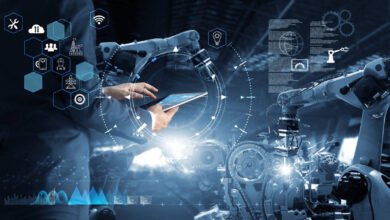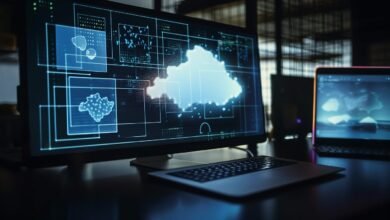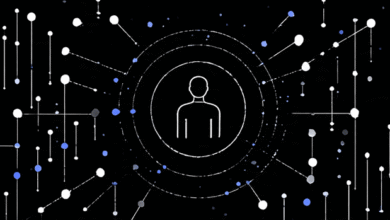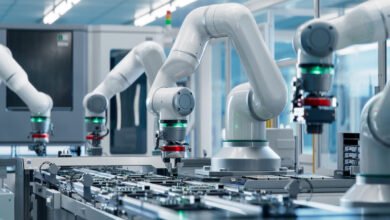The Role of AI in Enhancing Blockchain Security and Efficiency
Discover how AI in blockchain revolutionizes security and efficiency through smart contracts, fraud detection, and automated consensus mechanisms in 2025.

The convergence of artificial intelligence and blockchain technology represents one of the most transformative developments in modern digital infrastructure. While blockchain ensures transparency, immutability, and decentralization, AI brings advanced automation, predictive analytics, and real-time threat detection. This powerful combination addresses critical challenges that have long hindered blockchain adoption, particularly in areas of security vulnerabilities and scalability limitations.
In 2025, blockchain networks have already experienced over $2.17 billion in stolen cryptocurrency, with major platforms facing large-scale attacks. Simultaneously, traditional blockchain systems struggle with transaction throughput limitations and energy-intensive consensus mechanisms. AI blockchain integration emerges as a solution that not only fortifies security protocols but also optimizes operational efficiency across distributed networks.
The synergy between machine learning and blockchain security creates unprecedented opportunities for proactive threat detection, intelligent automation, and enhanced data integrity. From smart contract auditing to consensus algorithm optimization, AI technologies are reshaping how blockchain networks operate, scale, and protect against evolving cyber threats. This article explores the comprehensive ways AI enhances both the security posture and operational efficiency of blockchain systems, examining real-world applications, emerging trends, and future implications for various industries.
As organizations increasingly adopt blockchain solutions for critical operations, understanding how AI can address inherent limitations becomes essential. The integration of AI into blockchain applications has shown promise in addressing key challenges such as security, consensus, scalability, and interoperability, positioning this technological convergence as a cornerstone of next-generation distributed systems.
Understanding AI-Blockchain Integration
The Foundation of AI-Powered Blockchain Systems
Artificial intelligence in blockchain operates across multiple layers of distributed ledger technology, creating intelligent systems that can adapt, learn, and optimize performance in real-time. The convergence of the two technologies provides an unparalleled layer of solutions, especially in the areas of data robustness, transparency, and process optimization. This integration transforms static blockchain networks into dynamic, self-improving systems capable of addressing complex challenges.
The fundamental principle behind AI blockchain technology lies in leveraging machine learning algorithms to analyze vast amounts of transaction data, identify patterns, and make predictive decisions. The purpose of blockchain is to securely store a substantial amount of data that is visible to everyone, making it an ideal provider for the vast volumes of data typically required to train deep learning models. This symbiotic relationship creates a feedback loop where blockchain provides secure, immutable data for AI training, while AI enhances blockchain operations through intelligent automation.
Core Components of AI-Enhanced Blockchain
Machine learning algorithms form the backbone of intelligent blockchain systems, operating at various levels:
- Data Layer Intelligence: AI algorithms analyze transaction patterns, detect anomalies, and ensure data integrity
- Network Layer Optimization: Machine learning optimizes node communication, reduces latency, and improves network efficiency
- Application Layer Enhancement: Intelligent smart contracts and decentralized applications (DApps) that can adapt and evolve
- Consensus Layer Innovation: AI-driven consensus mechanisms that balance security, speed, and energy efficiency
AI technologies, including machine learning, deep learning, and reinforcement learning, have been effectively adopted to optimize blockchain consensus algorithms, improve smart contract vulnerability detection, and enhance privacy protection. This multi-layered approach ensures comprehensive enhancement of blockchain systems across all operational dimensions.
AI-Driven Security Enhancements in Blockchain
Advanced Threat Detection and Prevention
AI-powered blockchain security represents a paradigm shift from reactive to proactive cybersecurity measures. By analyzing each transaction, this adds an extra degree of protection by enabling the implementation of additional security procedures for high-risk transactions. Machine learning algorithms continuously monitor network activity, identifying suspicious patterns and potential threats before they materialize into actual attacks.
Modern fraud detection systems leverage sophisticated AI techniques including:
Anomaly Detection: Machine learning models analyze historical transaction patterns to identify deviations that may indicate fraudulent activity. AI recognizes questionable transaction patterns, like abrupt spikes in activity from unfamiliar addresses, using anomaly detection models. These systems can process thousands of transactions per second, flagging potentially malicious activities for further investigation.
Behavioral Analysis: AI systems create detailed profiles of normal user behavior, detecting when accounts exhibit unusual patterns that suggest compromise or malicious intent. AI may give risk rankings to people and transactions based on variables including counterparty involvement, geography, and transaction size.
Real-Time Monitoring: Continuous surveillance of blockchain networks enables immediate response to security threats. AI can monitor the blockchain for any unusual activity or changes in data, alerting administrators to potential security breaches.
Smart Contract Security Auditing
Smart contract vulnerabilities represent one of the most significant risks in blockchain ecosystems. In 2025, over $1 billion was lost due to flaws like reentrancy, missing access checks, and arithmetic overflows. AI-driven auditing systems provide comprehensive security analysis that surpasses traditional manual review methods.
Automated Vulnerability Detection: AI-powered tools scan smart contract code for common vulnerabilities, security flaws, and potential exploit vectors. AI-based auditing tools thoroughly review smart contracts for vulnerabilities and coding errors. This proactive approach prevents potential security breaches and disputes.
Code Analysis: Deep learning models analyze contract logic, identifying subtle bugs and security issues that human auditors might miss. These systems learn from historical vulnerabilities to improve detection accuracy continuously.
Predictive Security Assessment: Machine learning algorithms predict potential future vulnerabilities based on code patterns and deployment environments, enabling proactive security measures.
Sybil Attack Prevention
Sybil attacks pose significant threats to decentralized networks, where malicious actors create multiple fake identities to manipulate consensus mechanisms. Through network pattern analysis and the identification of anomalous clustering, AI is able to identify and flag possible Sybil attacks in real-time.
AI systems employ multiple techniques for Sybil detection:
Graph Neural Networks (GNNs): AI detects groups of accounts displaying Sybil-like behavior by analyzing blockchain transaction networks. These advanced algorithms map relationships between accounts, identifying suspicious clustering patterns.
Reputation-Based Filtering: AI reduces the impact of false identities by giving wallets trust levels based on past activity. This approach creates dynamic trust scores that evolve based on historical behavior patterns.
Network Topology Analysis: Machine learning models analyze network structure to identify artificial node clusters and unusual connectivity patterns that suggest coordinated malicious activity.
AI-Powered Efficiency Optimization
Consensus Mechanism Enhancement
Traditional consensus algorithms like Proof of Work (PoW) suffer from significant efficiency limitations, including high energy consumption and slow transaction processing. AI introduces efficiency by predictive modeling, where machine learning models can predict the likelihood of a node acting maliciously, reducing the need for exhaustive consensus checks.
Adaptive Consensus Protocols: AI systems dynamically adjust consensus parameters based on real-time network conditions. AI dynamically adjusts consensus parameters based on network conditions, ensuring faster and more energy-efficient agreement. This adaptability allows blockchain networks to optimize performance while maintaining security standards.
Predictive Validation: Machine learning algorithms analyze node behavior patterns to predict validation outcomes, reducing computational overhead and accelerating consensus achievement. Reinforcement Learning (RL) algorithms optimize consensus protocols by learning optimal strategies to reduce latency and resource consumption.
Energy Optimization: AI-driven consensus mechanisms significantly reduce power consumption by intelligently selecting validators and optimizing mining processes. This addresses one of the primary criticisms of traditional blockchain systems.
Scalability Solutions Through AI
Blockchain scalability remains a critical challenge for mainstream adoption. AI contributes to efficient storage management through data pruning, where AI algorithms identify redundant or low-value data for pruning, reducing storage requirements without compromising integrity.
Dynamic Sharding: AI algorithms optimize shard allocation and management in sharded blockchain networks. Dynamic sharding divides a blockchain into smaller segments (shards) to process transactions in parallel. Machine learning models determine optimal sharding strategies based on transaction patterns and network load.
Network Optimization: Machine learning identifies bottlenecks in peer-to-peer networks and reroutes traffic for faster data propagation. This intelligent traffic management reduces latency and improves overall network performance.
Compression and Storage Efficiency: AI-powered compression techniques optimize data storage, allowing nodes to handle larger blockchains efficiently. Advanced algorithms reduce storage requirements while maintaining data integrity and accessibility.
Transaction Processing Optimization
AI enhances transaction processing through multiple mechanisms:
Transaction Prioritization: Machine learning algorithms analyze transaction characteristics to optimize processing order, reducing wait times for high-priority transactions while maintaining network fairness.
Fee Optimization: AI systems predict optimal transaction fees based on network congestion and historical patterns, helping users balance cost and processing speed.
Batch Processing: Intelligent batching algorithms group compatible transactions to maximize throughput and minimize processing overhead.
Real-World Applications and Use Cases
Financial Services and DeFi
The integration of AI and blockchain in financial services creates robust, efficient, and secure financial ecosystems. AI automates customer service processes in decentralized finance, enhancing user experiences and increasing satisfaction rates.
Automated Trading Systems: AI-powered smart contracts execute trades based on complex market analysis and predetermined conditions. These systems process vast amounts of market data in real-time, making split-second decisions that human traders cannot match.
Risk Assessment: Machine learning models analyze borrower behavior, market conditions, and historical data to provide accurate risk assessments for DeFi lending protocols. This enables more efficient capital allocation and reduced default rates.
Fraud Prevention: AI systems monitor DeFi protocols for suspicious activities, including wash trading, market manipulation, and exploit attempts. Real-time analysis prevents significant financial losses and maintains market integrity.
Supply Chain Management
Blockchain supply chain applications benefit significantly from AI integration, creating transparent, efficient, and secure logistics networks. AI algorithms analyze data from the manufacturing process recorded on the blockchain, allowing for predictive maintenance and quality control, helping to identify and address issues before they result in defects or downtime.
Predictive Analytics: AI systems analyze supply chain data to predict demand, optimize inventory levels, and prevent stockouts or overstock situations. This intelligence reduces waste and improves operational efficiency.
Quality Control: Machine learning algorithms monitor product quality throughout the supply chain, identifying potential issues before they reach consumers. This proactive approach reduces recalls and enhances brand reputation.
Logistics Optimization: AI optimizes shipping routes, warehouse operations, and delivery schedules based on real-time data analysis, reducing costs and improving delivery times.
Healthcare Data Management
The combination of AI and blockchain in healthcare addresses critical challenges related to data privacy, security, and interoperability. Machine learning can be used to analyze data from multiple sources, such as clinical trial data and drug efficacy data, to optimize drug development and improve patient outcomes.
Secure Data Sharing: Blockchain ensures patient data privacy and security while AI enables intelligent analysis without compromising confidentiality. This balance enables collaborative research while protecting sensitive information.
Drug Development: AI algorithms analyze clinical trial data stored on blockchain networks to identify promising drug candidates and optimize development processes. This integration accelerates innovation while maintaining data integrity.
Personalized Treatment: Machine learning models analyze patient data to recommend personalized treatment plans, while blockchain ensures the security and authenticity of medical records.
Internet of Things (IoT) Integration
IoT blockchain integration enhanced by AI creates intelligent, secure, and efficient device networks. AI and blockchain can work together to secure the massive amount of data generated by IoT devices in an Industry 4.0 setting. Blockchain ensures the integrity and immutability of IoT data, while AI can analyze this data for insights and optimization.
Device Authentication: AI systems verify IoT device authenticity and behavior, preventing unauthorized access and ensuring network security. Machine learning models create behavioral profiles for devices, detecting anomalies that suggest compromise.
Data Analytics: AI processes massive amounts of IoT data stored on blockchain networks, extracting valuable insights for operational optimization and predictive maintenance.
Energy Management: AI and blockchain can facilitate the creation of decentralized energy grids where AI algorithms optimize energy distribution and blockchain ensures transparent and secure energy trading through smart contracts.
Emerging Trends and Future Developments
Federated Learning on Blockchain
Federated learning represents a significant advancement in AI-blockchain integration, enabling collaborative machine learning while preserving data privacy. Class 1 involves the use of blockchain to build and realize a federated learning platform. This approach allows multiple organizations to train AI models collectively without sharing sensitive data.
The benefits of blockchain-enabled federated learning include:
Data Privacy: Participants contribute to model training without exposing raw data, maintaining confidentiality while benefiting from collective intelligence.
Incentive Mechanisms: Blockchain-based reward systems encourage participation in federated learning networks, ensuring sustainable collaboration.
Model Integrity: Immutable blockchain records ensure the authenticity and version control of machine learning models, preventing malicious modifications.
Autonomous Decentralized Organizations (DAOs)
AI-enhanced DAOs represent the next evolution of decentralized governance systems. AI algorithms can analyze smart contracts within DAOs, identifying potential vulnerabilities or inefficiencies. This helps in enhancing the security and reliability of these self-operating organizations.
Intelligent Governance: AI systems analyze proposal outcomes, member behavior, and organizational performance to suggest governance improvements and predict decision impacts.
Automated Decision Making: Machine learning algorithms can execute routine organizational decisions based on predefined criteria, reducing the need for constant member voting on minor issues.
Conflict Resolution: AI-powered dispute resolution systems analyze conflicts and suggest fair solutions based on historical precedents and organizational rules.
Cross-Chain Intelligence
The future of blockchain ecosystems lies in interoperability between different networks. AI plays a crucial role in enabling seamless cross-chain operations:
Protocol Translation: AI systems translate transactions and data formats between different blockchain protocols, enabling seamless interaction.
Bridge Security: Machine learning algorithms monitor cross-chain bridges for vulnerabilities and potential attacks, enhancing security in multi-chain ecosystems.
Liquidity Optimization: AI optimizes asset movement between chains to minimize costs and maximize efficiency in cross-chain transactions.
Zero-Knowledge AI
The integration of zero-knowledge proofs with AI creates powerful privacy-preserving systems. Modulus Labs enables AI models to be executed within smart contracts using zero-knowledge proofs (ZKPs), making it possible to run AI computations verifiably onchain without sacrificing speed or cost efficiency.
Private AI Inference: Users can leverage AI services without revealing input data, maintaining privacy while benefiting from advanced analytics.
Verifiable Computation: Zero-knowledge proofs ensure that AI computations are performed correctly without revealing the underlying algorithms or data.
Scalable Privacy: These systems enable privacy-preserving AI at scale, making it practical for widespread adoption in sensitive applications.
Challenges and Limitations
Technical Challenges
Despite significant advantages, AI blockchain integration faces several technical hurdles:
Computational Complexity: AI algorithms require substantial computational resources, potentially slowing down blockchain operations. Balancing intelligence with performance remains a critical challenge.
Scalability Trade-offs: Adding AI capabilities to blockchain systems can introduce new scalability limitations, requiring careful optimization to maintain network efficiency.
Model Accuracy: AI systems must maintain high accuracy levels to avoid false positives in security applications, as errors can have significant consequences in financial and security contexts.
Data Quality and Availability
Machine learning effectiveness depends heavily on data quality and availability:
Data Standardization: We identify novel machine learning algorithms, the lack of a standardization framework, blockchain scalability issues and cross-chain interactions as areas worth exploring in the future. Blockchain networks often use different data formats, making it challenging to develop universal AI solutions.
Training Data Bias: Historical blockchain data may contain biases that AI systems inadvertently learn and perpetuate, potentially leading to unfair or discriminatory outcomes.
Privacy Constraints: Regulatory requirements and privacy concerns limit access to training data, potentially reducing AI system effectiveness.
Integration Complexity
Combining AI and blockchain technologies presents significant integration challenges:
Protocol Compatibility: Ensuring AI systems work seamlessly with existing blockchain protocols requires extensive development and testing.
Update Mechanisms: Updating AI models in immutable blockchain systems requires careful design to maintain system integrity while enabling improvements.
Governance Issues: Decisions about AI system updates and parameters require consensus mechanisms that may be complex to implement and maintain.
Regulatory and Compliance Considerations
The intersection of AI and blockchain creates complex regulatory landscapes:
Compliance Monitoring: AI systems must comply with evolving regulations regarding data privacy, algorithmic transparency, and financial services.
Liability Questions: Determining responsibility for AI-driven decisions in decentralized systems presents legal challenges that regulators are still addressing.
Cross-Jurisdictional Issues: Global blockchain networks must navigate different regulatory frameworks, complicating compliance efforts.
Implementation Best Practices
Security-First Design Principles
Implementing AI blockchain security requires adherence to fundamental security principles:
Defense in Depth: Deploy multiple layers of AI-powered security measures to create comprehensive protection against various threat vectors.
Continuous Monitoring: Implement real-time monitoring systems that can detect and respond to security threats immediately.
Regular Auditing: Conduct frequent security audits of both AI algorithms and blockchain components to identify and address vulnerabilities.
Performance Optimization Strategies
Maximizing blockchain efficiency through AI requires strategic implementation approaches:
Incremental Deployment: Gradually introduce AI capabilities to existing blockchain systems, monitoring performance impacts and adjusting as needed.
Resource Management: Carefully allocate computational resources between AI processing and blockchain operations to maintain optimal performance.
Caching and Optimization: Implement intelligent caching mechanisms that reduce redundant computations while maintaining system accuracy.
Governance and Transparency
Successful AI-blockchain integration requires proper governance frameworks:
Algorithm Transparency: Provide clear documentation and explanation of AI decision-making processes to maintain trust and enable oversight.
Community Involvement: Engage stakeholders in decisions about AI system parameters and updates to ensure broad acceptance and legitimacy.
Audit Trails: Maintain comprehensive logs of AI system decisions and performance metrics to enable accountability and continuous improvement.
Industry Impact and Economic Implications
Market Growth and Adoption
The AI blockchain market is experiencing rapid expansion across multiple sectors. The global blockchain security market is projected to grow from an estimated US$20bn in 2024 to $250bn in the next five years as companies leverage the technology to enhance a variety of different processes. This growth is driven by increasing recognition of AI’s potential to address blockchain limitations and enhance security.
Investment Trends: Venture capital and enterprise investment in AI-blockchain startups has surged, indicating strong market confidence in the technology combination’s potential.
Enterprise Adoption: Large corporations are increasingly experimenting with AI-enhanced blockchain solutions for supply chain management, financial services, and data security applications.
Startup Innovation: Numerous startups are developing specialized AI-blockchain solutions, creating a vibrant ecosystem of innovation and competition.
Cost-Benefit Analysis
Organizations considering AI blockchain implementation must carefully evaluate economic implications:
Development Costs: Initial investment in AI-blockchain systems can be substantial, requiring specialized expertise and infrastructure.
Operational Savings: Long-term operational benefits include reduced fraud losses, improved efficiency, and automated processes that decrease manual intervention requirements.
Risk Mitigation: Enhanced security measures reduce potential losses from cyberattacks and system failures, providing significant economic protection.
Competitive Advantages
Organizations successfully implementing AI-enhanced blockchain systems gain several competitive advantages:
Operational Excellence: Improved efficiency and automation enable organizations to operate more effectively than competitors using traditional systems.
Trust and Transparency: Enhanced security and transparency build customer trust and enable new business models based on verified data sharing.
Innovation Capabilities: AI-blockchain platforms enable rapid experimentation and deployment of new services and features.
Conclusion
The integration of artificial intelligence and blockchain technology represents a transformative force that addresses fundamental challenges in both security and efficiency. Through advanced threat detection, smart contract auditing, and consensus optimization, AI enhances blockchain systems’ ability to protect against evolving cyber threats while significantly improving operational performance. Artificial intelligence, with its powerful data processing capability, pattern recognition ability, and adaptive optimization algorithms, can improve the transaction processing efficiency of blockchain, enhance the security mechanism, and optimize the privacy protection strategy. Real-world applications across financial services, supply chain management, healthcare, and IoT demonstrate the practical value of this technological convergence. While challenges remain in areas of computational complexity, data standardization, and regulatory compliance, emerging trends in federated learning, autonomous organizations, and zero-knowledge AI point toward a future where intelligent blockchain systems become the foundation for secure, efficient, and transparent digital infrastructure. Organizations that strategically implement AI-enhanced blockchain solutions today position themselves at the forefront of this technological revolution, gaining competitive advantages through improved security, operational excellence, and innovative capabilities that will define the next generation of distributed systems.











